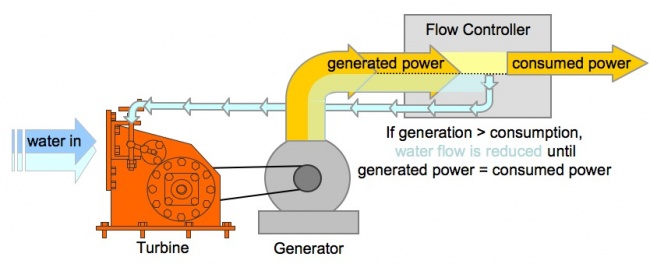Knowledge fuels change - Support energypedia!
For over 10 years, energypedia has been connecting energy experts around the world — helping them share knowledge, learn from each other, and accelerate the global energy transition.
Today, we ask for your support to keep this platform free and accessible to all.
Even a small contribution makes a big difference! If just 10–20% of our 60,000+ monthly visitors donated the equivalent of a cup of coffee — €5 — Energypedia would be fully funded for a whole year.
Is the knowledge you’ve gained through Energypedia this year worth €5 or more?
Your donation keeps the platform running, helps us create new knowledge products, and contributes directly to achieving SDG 7.
Thank you for your support, your donation, big or small, truly matters!
Electrical-Mechanical Equipment
Ballast or dump load
A ballast load is mostly an electrical resistance heater. It's sized to handle the
full generating capacity of the microhydro turbine. They're placed in air or water. If there is more electricity produced then consumed the charge controller uses this excess energy to generate heat.
Other but not common ballast load may be pumping water or ice production.
Load factor
The load factor is the amount of power used divided by the amount of power that is available if the turbine were to be used continuously. Unlike technologies relying on costly fuel sources, the 'fuel' for hydropower generation is free and therefore the plant becomes more cost effective if run for a high percentage of the time. If the turbine is only used for domestic lighting in the evenings then the plant factor will be very low. If the turbine provides power for rural industry during the day, meets domestic demand during the evening, and maybe pumps water for irrigation in the evening, then the plant factor will be high.
It is very important to ensure a high plant factor if the scheme is to be cost effective and this should be taken into account during the planning stage. Many schemes use a 'dump' load (in conjunction with an electronic load controller - see below), which is effectively a low priority energy demand that can accept surplus energy when an excess is produced e.g. water heating, storage heaters or storage cookers.
Turbine types
[[Image:]]
A turbine converts the energy in falling water into shaft power. There are various types of turbine which can be categorized in one of several ways. The choice of turbine will depend mainly on the pressure head available and the design flow for the proposed hydropower installation. As shown in table 2 below, turbines are broadly divided into three groups; high, medium and low head, and into two categories: impulse and reaction.
Turbine Runner |
Head pressure | ||
|
High |
Medium |
Low | |
|
Impulse |
Pelton Turgo Multi-jet Pelton |
Crossflow Turgo Multi-jet Pelton |
Crossflow |
|
Reaction |
Francis Pump-as-turbine (PAT) |
Propeller Kaplan |
|
The difference between impulse and reaction can be explained simply by stating that the impulse turbines convert the kinetic energy of a jet of water in air into movement by striking turbine buckets or blades - there is no pressure reduction as the water pressure is atmospheric on both sides of the impeller. The blades of a reaction turbine, on the other hand, are totally immersed in the flow of water, and the angular as well as linear momentum of the water is converted into shaft power - the pressure of water leaving the runner is reduced to atmospheric or lower.
Load control governors
Water turbines, like petrol or diesel engines, will vary in speed as load is applied or relieved. Although not such a great problem with machinery which uses direct shaft power, this speed variation will seriously affect both frequency and voltage output from a generator. Traditionally, complex hydraulic or mechanical speed governors altered flow as the load varied, but more recently an electronic load controller (ELC) has been developed which has increased the simplicity and reliability of modern micro-hydro sets. The ELC prevents speed variations by continuously adding or subtracting an artificial load, so that in effect, the turbine is working permanently under full load. A further benefit is that the ELC has no moving parts, is very reliable and virtually maintenance free. The advent of electronic load control has allowed the introduction of simple and efficient, multi-jet turbines, no longer burdened by expensive hydraulic governors.
Controller:
Function principles
Load- or Flow- controller ensure that the power output does not exceed the power demand (e.g. 230V, 50 Hz).
If flow of water in a MHP-station is constant the energy output of a turbine/generator is constant as well. Power demand is usually fluctuating over the time (e.g. day/night). If supply is higher than demand, excess energy must be diverted / dumped. Alternatively the water flow can be reduced which results also in less power output.
In case of more power demand than supply the controller cuts of the of single users (clusters) in order to keep voltage and frequency constant.
Load controller are placed between generator output and the consumer line.
Controller Types
Load controller:
Electronic circuit, which keeps output power constant in Frequency- and Voltage- parameters.
Fluctuating energy demand requires a mechanism which either regulates the water input into the turbine (= flow control) or by diverting excess energy from the consumer connection (= ballast load).
Ballast load
usually electrical heaters in water or air. If energy demand is temporarily low the excess energy is converted into heat.
Flow control
regulates the amount of water into the turbine in order to match power output and power demand.
Nowadays flow control is done mostly via electronics (which steer a valve)






















